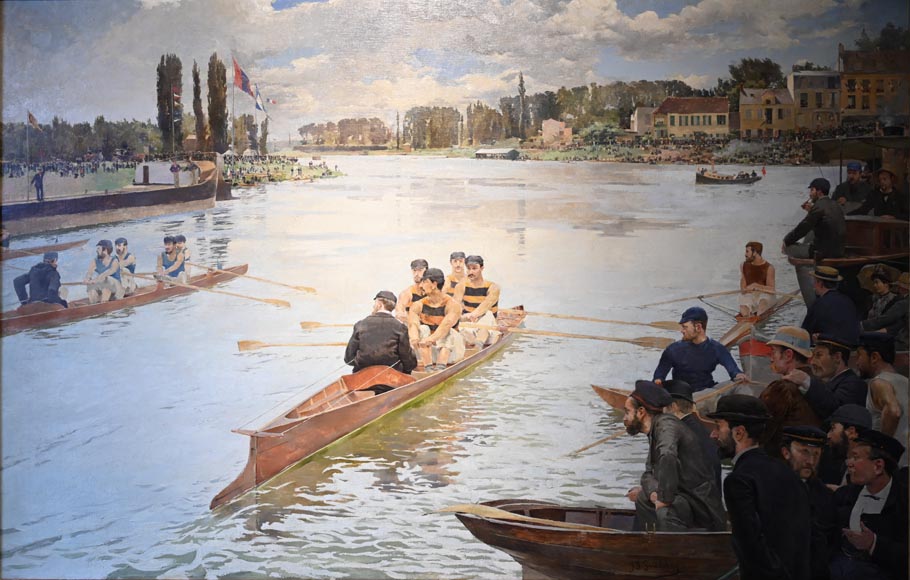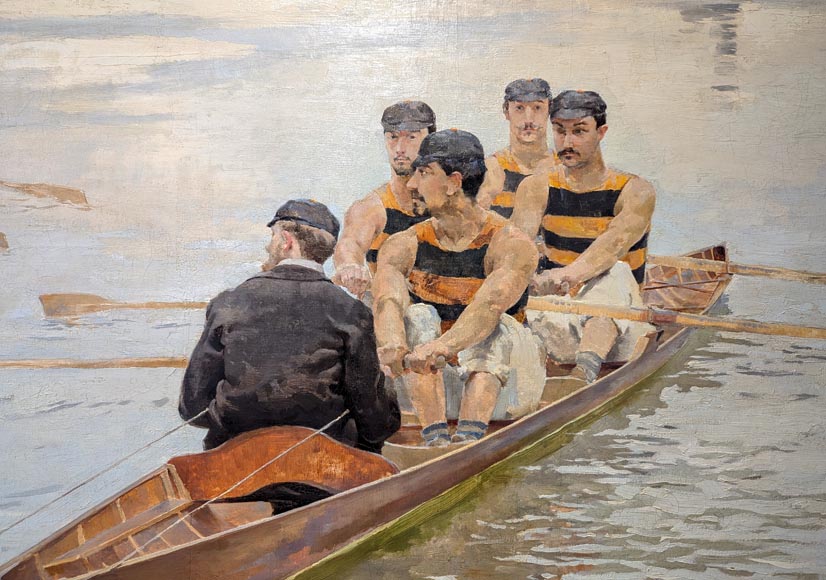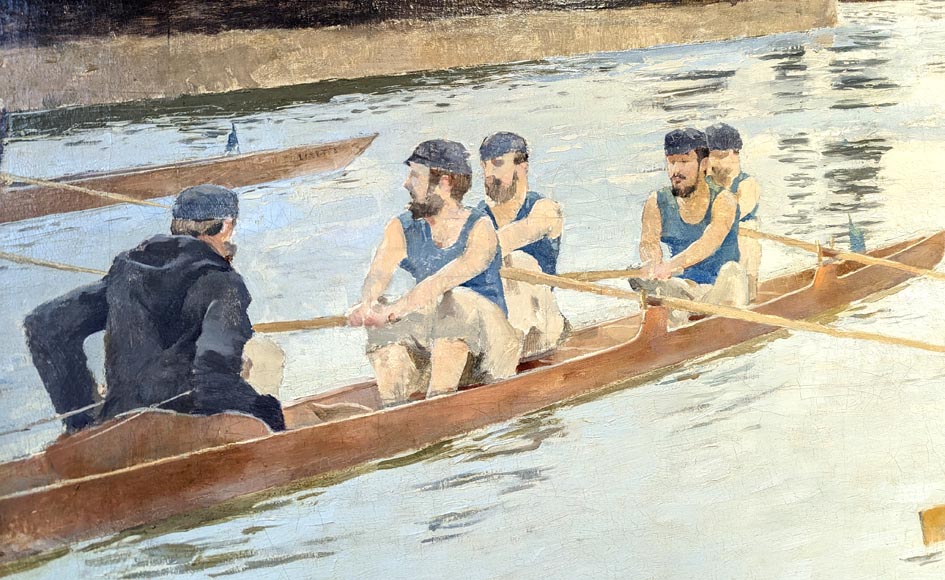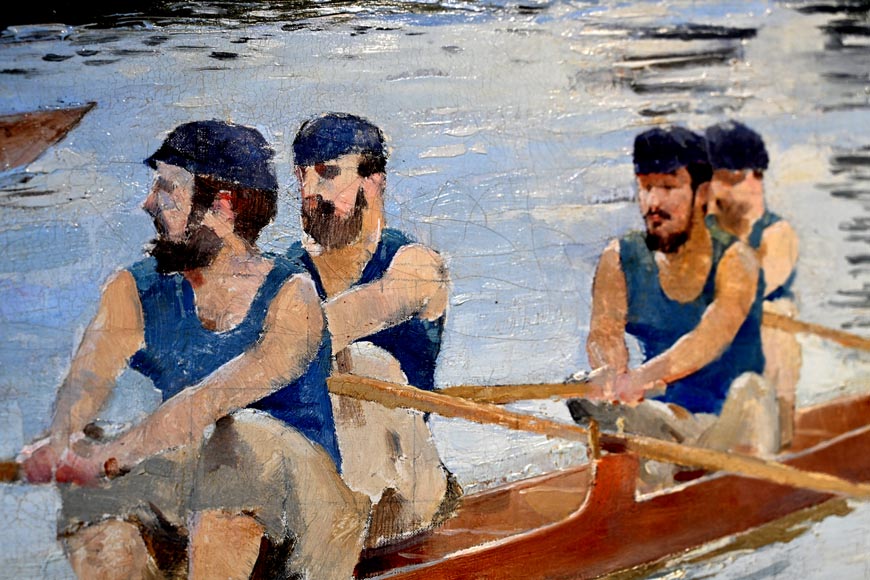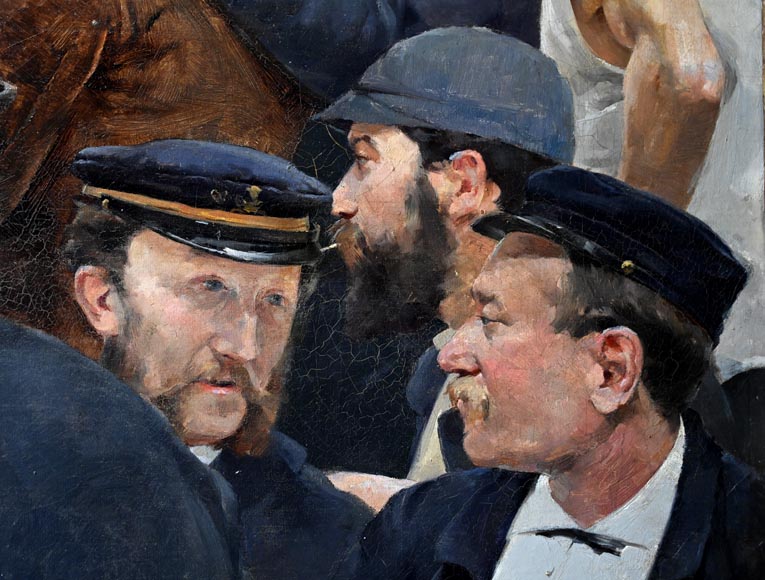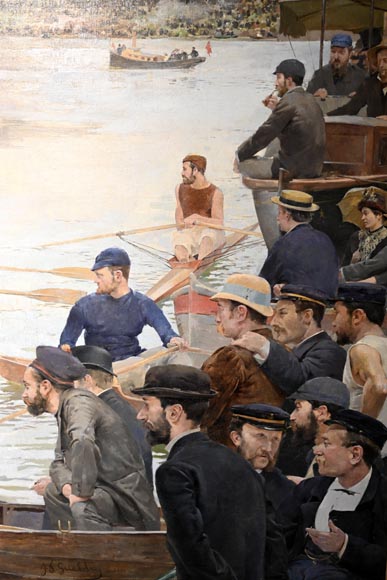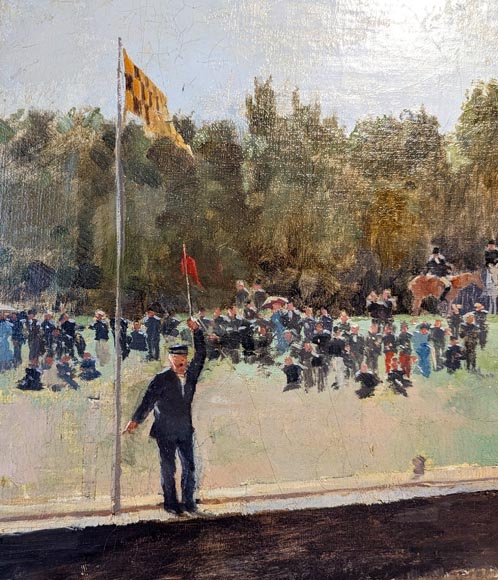Style Other / Ref.14000
Ferdinand GUELDRY, Regatta at Joinville, 1881
Dimensions:
Width: 102'' 259cm
Height: 74'' 188cm
Depth: 8'' ⅝ 22cm
Inner width: 78'' ¾ 200cm
Inner height: 50'' ⅜ 128cm
Origin:
19th century
Status:
Good condition
A Regatta at Joinville. The Start is an oil on canvas painted by Ferdinand Gueldry in 1881, which he presented at the Salon of that same year.
Born on May 21, 1858, in Paris and died in 1945 in Lausanne (Switzerland), the painter Ferdinand Joseph Gueldry showed an early interest in painting. Between 1874 and 1878, he attended the studio of Jean-Léon Gérôme at the École des Beaux-Arts in Paris. At the same time, he developed a passion for rowing, a sport he practiced with skill. Thus, in 1876, he co-founded the Société Nautique de la Marne, in Joinville-le-Pont.
A Regatta at Joinville is, to our knowledge, his first major painting on the subject and marks the beginning of a body of work centered on the depiction of nautical scenes. Gueldry then settled in Bry-sur-Marne, where he could combine his painting practice with this sport. He became an international rowing referee and traveled several times to England in this capacity. Critics were enthusiastic: Gueldry managed to distance himself from the academic teachings of his master Gérôme and go “straight to nature” (Joris-Karl Huysmans, "Modern Art", 1902, p. 208).
Subsequently, Gueldry expanded his subject matter to almost documentary representations of factory interiors and working-class life. He also painted a few military scenes, seascapes, rural scenes, interior scenes, and rare portraits. During World War I, he sought to depict the horror of the trenches.
In 1895, he married one of the daughters of Richard-Gabriel Morris, the promoter of the columns that bear his name in Paris. In 1908, he was named a Knight of the Legion of Honor. Gueldry participated in numerous Universal Exhibitions between 1889 and 1904, winning several medals. In 1912, he competed in the Stockholm Olympics and was a finalist in the painting category.
At the 1881 Salon, A Regatta at Joinville was exhibited under number 1061. One of the exhibition’s commentators, Louis Enault, described it as a “great scene of boating, lively and cheerful” (Louis Enault, "Guide to the Paris Salon. 1881", 1881, p. 16). In "Art and Artists" at the 1881 Salon (Paris, 1881), Maurice du Seigneur notes that it is “a work that is entirely in the modern trend, impressionist in the good sense of the word, delightful with bright, harmonious, and sunny tones, where the air circulates from the foreground to the distant horizons. [...] The Regatta at Joinville is the starting point of a great original talent”.
The painting later entered the collection of the industrialist and collector Pierre-Yves Le Diberder until it was sold along with the rest of his collection in 2016.
The painter, who had a great fondness for these subjects, painted many works in the vein of A Regatta. In 1883, he notably depicted The Annual Match between the Société Nautique de la Marne and the Rowing Club, following the victory of the former over the latter in a match between Boulogne and Suresnes on April 23, 1882. While A Regatta at Joinville depicts the moment of the start, this painting captures the finish, with a referee waving a red flag on the left side of the canvas. The winners are already celebrating their victory by saluting the crowd gathered on the bridge, while the runners-up are still rowing to cross the finish line. Gueldry plays with the aquatic environment, varying it according to the situation. The water, relatively calm before the start of A Regatta at Joinville, is still stirred by the passage of the Rowing Club’s boat in The Annual Match.
Gueldry did not only represent competitions. He was also interested in rowing as a leisure activity, as shown in his painting The Lock (1888, Musée des Beaux-Arts in de Reims). A few years later, he revisited the same subject in a less popular tone with The Molesey Lock (1896, Nogent-sur-Marne Museum). This painting testifies to the success of rowing among the wealthiest populations, with the congestion in a lock on a sunny day of rest.
A Regatta at Joinville thus marks the beginning of numerous paintings depicting scenes of nautical competitions or rowing. Ferdinand Gueldry was extremely renowned for this aspect of his work and remains known for the beautiful luminosity of his outdoor scenes and his fondness for the nautical environment.
Informations
Price: on request
Recommended for you :
Dimensions:
Width: 77
Height: 110
Depth: 5
Dimensions:
Width: 495
Height: 351
Dimensions:
Width: 420
Height: 253
Depth: 3
Dimensions:
Width: 65
Height: 195
Depth: 3
Dimensions:
Width: 122
Height: 240
Dimensions:
Width: 67
Height: 95
Depth: 2
Dimensions:
Width: 130
Height: 100
Depth: 7
Dimensions:
Width: 86
Height: 108
Dimensions:
Width: 162
Height: 295
Depth: 14
Dimensions:
Width: 68
Height: 325
Dimensions:
Width: 267
Height: 210
Depth: 16
Inner width: 228
Inner height: 166




